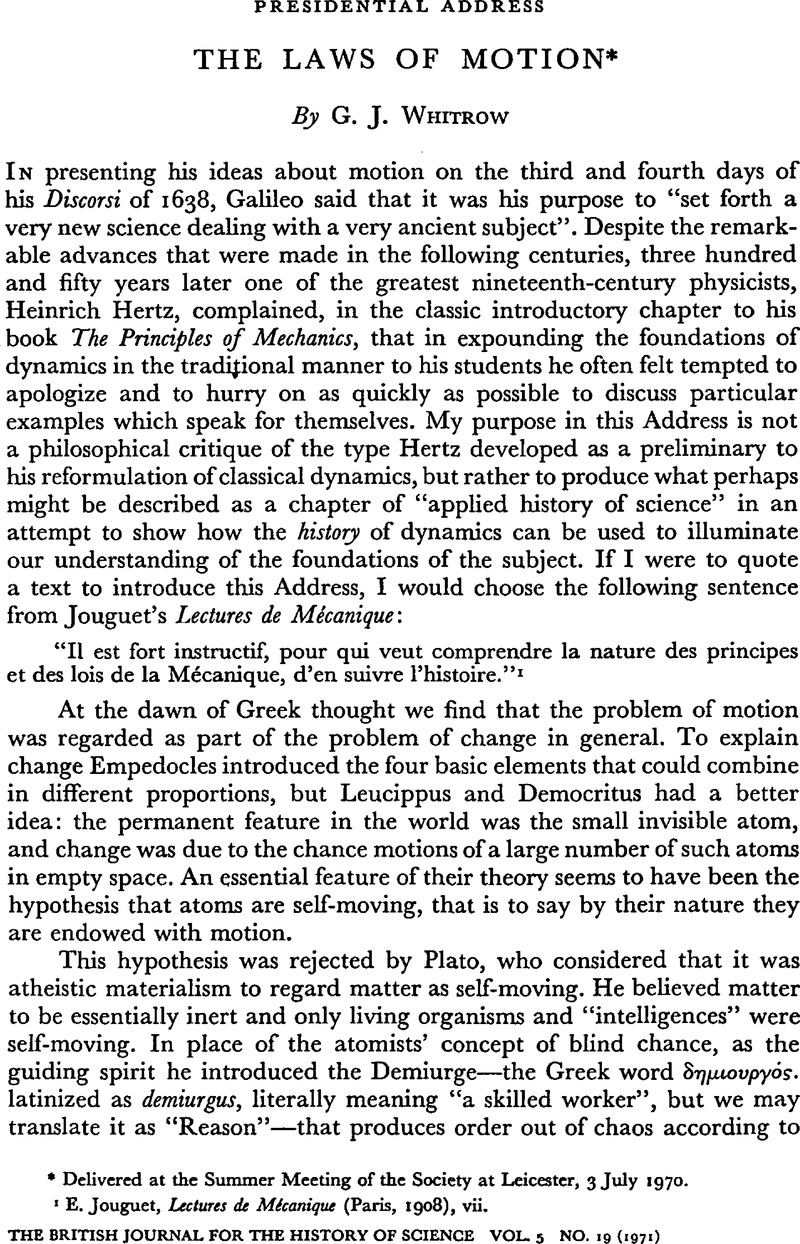Article contents
Abstract

- Type
- Presidential Address
- Information
- Copyright
- Copyright © British Society for the History of Science 1971
References
1 Jouguet, E., Lectures de Mécanique (Paris, 1908), vii.Google Scholar
2 Lamar Crosby, H., Jr., Thomas of Bradwardine His Tractatus de Proportionibus: its Significance or the Development of Mathematical Physics (Madison, Wisconsin, 1955), 17.Google Scholar
3 Rosenfeld, L., Nature, ccxxii (1969), 197.CrossRefGoogle Scholar
4 Clagett, Marshall, The Science of Mechanics in the Middle Ages (Madison, Wisconsin; London, Oxford University Press, 1959), 261.Google Scholar
5 Ibid., 587.
6 Ibid., 666.
7 Galileo, Galileo, Dialogue concerning the two Chief World Systems—Ptolemaic and Copernican, trs. Drake, Stillman (Berkeley and Los Angeles, 1953), 186–187.Google Scholar
8 Koyré, A., Newtonian Studies (London, 1965), 66–67.CrossRefGoogle Scholar
9 Herivel, J. W., The Background to Newton's Principia (Oxford, 1965), 44–45.Google Scholar
10 Euler, L., “Découverte d'un nouveau principe de mécanique”, Mem. Acad. Sci. Berlin, vi (1752), 185–217.Google Scholar
11 Truesdell, G., Essays in the History of Mechanics, Berlin (Heidelberg and New York, 1968), 116.CrossRefGoogle Scholar
12 Ibid., 118.
13 Ibid., 239 et seq.
14 M Truesdell's playing down of Lagrange as compared with Euler, cf. his Essays in the History of Mechanics, 133–135, reflects his own interests. Euler's work in mechanics is of great value for the classical applied mathematician interested in fluid mechanics, etc., but Lagrange's work is of more value to the theoretical physicist interested in relativity, quantum theory, particle physics, etc.
15 d'Alembert, J., Traité de Dynamique (2nd ed., Paris, 1758, ed. Hankins, T. L., New York and London, 1968), “Discours Preliminaire”, xxii.Google Scholar
16 Ibid., Introduction, pp. xxxiii-xxxiv.
17 Lanczos, C., The Variational Principles of Mechanics (Toronto, 1949), 77 (footnote).Google Scholar
18 Jacobi, C. G. J., Vorlesungen über Dynamik, ed. Clebsch, A. (Berlin, 1866), Lectures 21, 23 and 24.Google Scholar
19 Milne, E. A., Kinematic Relativity (Oxford, 1948), 75.Google Scholar
20 Sciama, D. W., Monthly Notices of the Royal Astronomical Society, cxiii (1953), 34–42.CrossRefGoogle Scholar
21 Brill, D. R. and Cohen, J. M., Phys. Rev., cxliii (1966), 1011–1015.CrossRefGoogle Scholar
22 Bridgman, P. W., The Logic of Modern Physics (New York, 1927, reprinted 1960), 183.Google Scholar
- 1
- Cited by




